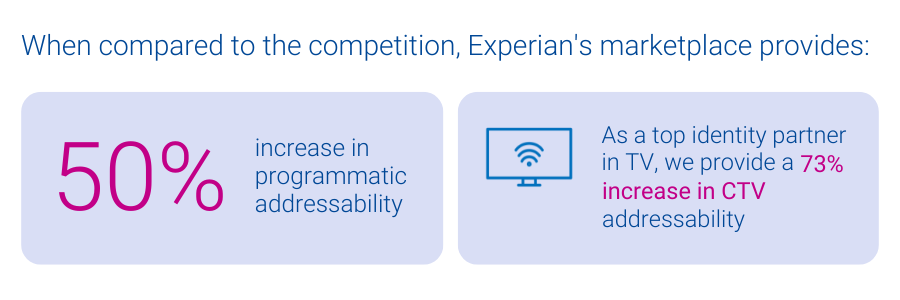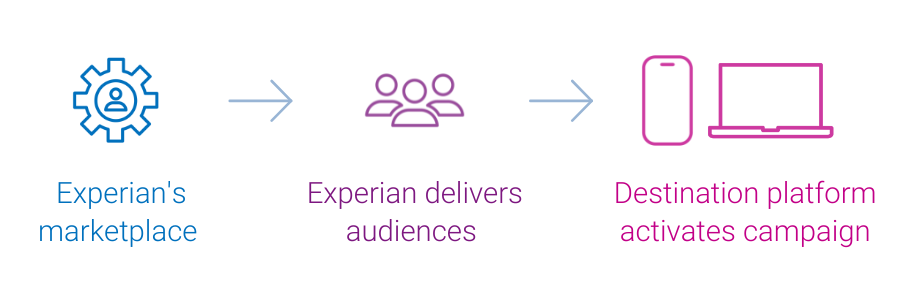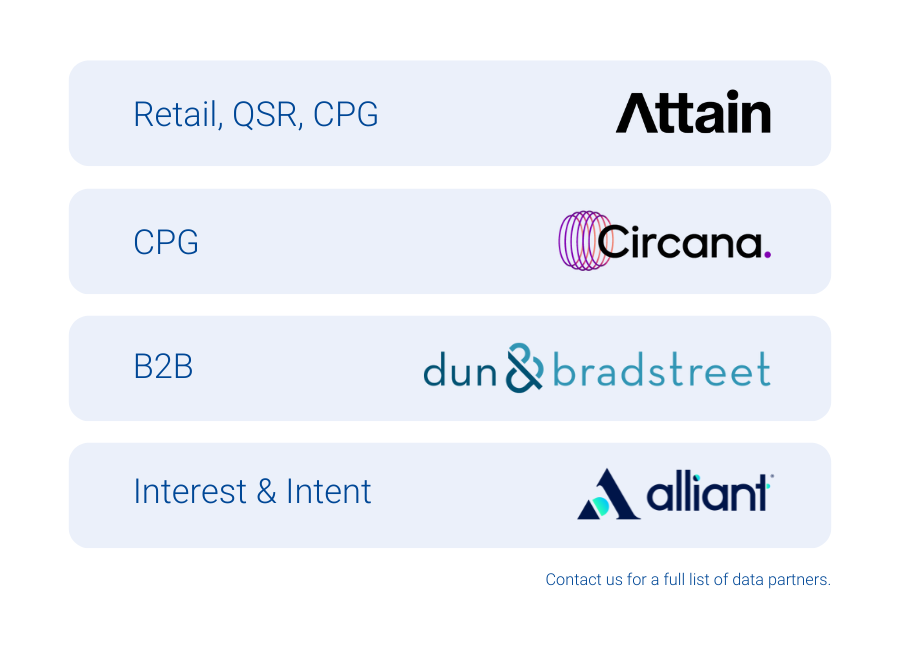
Following the success of our recent launch of Third-Party Onboarding, we are excited to introduce the Experian marketplace, a new addition to our portfolio of data-driven activation solutions.
Experian’s marketplace bridges TV operators, programmers, supply partners, and demand platforms with top-tier third-party audiences across retail, CPG, health, B2B, and location intelligence. Easily activate premium audiences from leaders like Attain, Alliant, Circana, and Dun & Bradstreet – driving precise, efficient consumer reach.
“Experian has been a longstanding partner of DISH Media, and we’re excited to be an early adopter of their marketplace which leverages the foundation of their identity solutions to ensure maximum cross-channel reach as we look to expand the breadth and depth of data we use for addressable TV.”
Kemal Bokhari, Head of Data, Measurement & Analytics, DISH Media
As privacy regulations evolve and traditional identity signals shift, many activation platforms face declining addressability. This impacts their ability to effectively reach consumers, which is critical to staying competitive. Experian’s marketplace, powered by our identity graphs which include 126 million households, 250 million individuals, and 4 billion active digital IDs, enables audiences to be easily activated and maintain high addressability across display, mobile, and connected TV (CTV) channels.


Benefits of Experian’s marketplace
- Enhanced addressability and match rates: All audiences delivered from our marketplace benefit from our best-in-class offline and digital identity graphs, which ensure addressability across all channels like display, mobile, and CTV. Unlike other data marketplaces, Experian ensures all identifiers associated with an audience have been active and are targetable, improving the accuracy of audience planning.
- Simplified audience planning and distribution for TV Operators: TV operators can build custom audiences matched directly to their subscriber footprint and distribute them across all advanced TV channels (data-driven linear, addressable, digital, and CTV) for maximum impact.
- Diversification within the data marketplace ecosystem: With the recent departure of Oracle’s advertising business, the optionality for buyers and sellers to connect with third-party data has become increasingly limited. With Experian marketplace, we’re excited to offer a new solution to the market that ensures data-driven targeting can continue to take place at scale.
- Lower activation costs: Experian’s marketplace offers transparent, pass-through pricing with no additional access fees, enabling partners to maximize their earnings while reducing costs.
- Audience diversity and scale: Platforms can access a broad range of audiences across top verticals from our partner audiences, which can be combined with 2,400+ Experian Audiences. This offers the flexibility, reach, and scale necessary to effectively execute advertising campaigns.
- Remove compliance concerns: Experian’s rigorous data partner review ensures available audiences comply to all federal, state and local consumer privacy regulations.
“Circana and Experian have enjoyed a deep partnership for over a decade. We are exceedingly excited to extend our partnership and be an early adopter and launch partner of the Experian data marketplace. This additional capability will enable the ecosystem to more easily access Circana’s purchase-based CPG and General Merchandise (for example Consumer Electronics, Toys, Beauty, Apparel etc.) audience segments to drive performance outcomes across all media channels.”
Patty Altman, President, Global Solutions, Circana

“Capturing the attention of target audiences across channels is critical for marketers navigating an increasingly connected digital world. We are excited to be an exclusive provider of B2B solutions within Experian’s marketplace, helping brands and media agencies to accelerate their reach, addressability and targeting capabilities across TV, mobile and connected TV channels.”
Georgina Bankier, VP of Platform Partnerships at Dun & Bradstreet
Better connections start here: Experian’s marketplace
Experian’s marketplace, easily accessible from our Audience Engine platform, brings unparalleled addressability, enabling our clients to reach more relevant consumers and increase revenue.
If you’re interested in learning more about Experian’s marketplace or becoming an active buyer or seller in our marketplace, please contact us.
Latest posts

The holiday season is right around the corner and retailers are gearing up for a massive influx of customers, both new visitors and returning loyal patrons. But, organizations need to make sure they’re prepared to handle the influx of business. Data quality should be a priority for retailers at any time of year, but even more so as the holiday season approaches. During this time, it’s important for companies to provide customers with relevant shopping offers. When consumers shop for holiday gifts for their friends and families, they have countless directions to which they can turn. In order to prevail in competition, retailers need to provide customers with relevant offers and messages. Unfortunately, many businesses fall short in this regard. According to recent research from Experian QAS, organizations feel that, on average, 25 percent of their data is inaccurate. Consumers are frantically looking to find deals on products that meet their holiday needs, but loyalty offers may not be reaching consumers. One reason for the difficulty is the messy nature of companies’ customer databases. Retail businesses are working hard to gather as much information as possible about the consumers who patronize them, but all too often, information is riddled with errors. These errors have become more prevalent in recent years due to the proliferation of mobile apps, web interfaces and social media channels. There are so many different channels that companies now interact with people through an average of 3.27 channels. This poor data quality is hurting organizational bottom lines. Experian QAS found that an average of 12 percent of departmental budgets are wasted due to inaccuracies in contact data. During the 2013 holiday season, consumer spending is expected to increase by at least 11 percent. Retailers need to be certain that they improve data quality prior to the holiday season to ensure communications reach consumers and resources are maximized in order to take advantage of the expected increase. Be sure to check out our new data quality infographic.

Experian Marketing Services’ Head of Global Research Bill Tancer appeared recently on Fox Business News to talk about new holiday shopping trends, including why both retailers and consumers are starting the 2013 season earlier this year. “We are seeing the eventual extinction of Black Friday,” says Tancer. “What we see in our data is that retail is really changing. The consumer is relentlessly searching for that deal.” In fact, as Tancer notes, the hyper-connected, digital consumer is already searching for holiday deals. Hear more from Tancer in this clip. Watch the latest video at video.foxbusiness.com Tancer and other Experian Marketing Services data experts will discuss holiday marketing trends at an upcoming webinar; register for more insights and tips.

On some level, collecting data and analyzing it to find meaningful conclusions has always been part of how marketers go about connecting with consumers. Their strategies have improved dramatically over time, though. Perhaps in a previous era, marketing executives were only able to make sweeping generalizations about large swathes of the population. But, as marketers have gathered more data on individual consumers, they’ve found ways to fine-tune their searches. They’re no longer messaging to groups in vague terms. Smart Data Collective recently examined the marketing world’s transition away from broad stereotyping toward better targeted forms of data mining. Josh Brown, a member of the marketing team at business and IT consulting company Iconic Mind, argues that this era of overgeneralization is coming to an end. We now have the capability to zoom in on the specific customer. “Big data is how successful companies are building more detailed models of consumer behavior,” Brown wrote. “Instead of relying on the traditional demographic models that marketers used when we were operating in a mass consumption environment and had nothing better, big data capitalizes on developing market trends to allow businesses to become far more specific when segmenting their customers.” Brown cited Amazon.com as an example. The online superstore is notable for its targeted recommendations of products that shoppers see every time they log on to the site – the advisements are impressive because they’re usually right up the customer’s alley. Amazon doesn’t generate these ideas by making guesses based on whether the consumer is old or young, male or female – instead, the site takes in specific information about people’s buying histories and looks for similar products. This approach is quickly becoming mainstream. It’s not hard to understand why – people don’t like being reduced to profiles of their demographic characteristics. Consumers are expecting more from the companies they do business with. Thanks to the rapidly improving technologies that companies use for data collection, marketers can be more targeted and make more intelligent interactions. However, to take advantage of these new technologies, marketers need to maintain high quality data. Without a data quality strategy, customer information will be spread out across the organization, making it difficult to make intelligent marketing offers. To learn more about improving your understanding of consumers, check-out our infographic on building a single customer view.